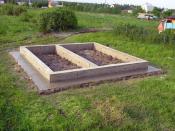Search
Login
Autonomous gasification of a private house, from design to commissioning
Most homeowners today prefer autonomous gas supply to suburban private homes. Interested and still non-gasified owners of country houses immediately ask the question:
Autonomous gas supply - what is it?
Content
- Who has the right to design gas supply systems
- Working draft autonomous gas supply at home video
- Gas holder: design, connection and maintenance
- Installation and commissioning of autonomous gas supply video
An autonomous gas supply installation can be conventionally represented as a sequential chain: project - installation - commissioning.
Autonomous gas supply is characterized by the main functions on which the system rests:
multifunctionality
practicality
profitability.
The gas supplied through the gas pipeline in the form of a vapor fraction, which ensures the operation of all gas equipment in the house, is used as the fuel of the autonomous system.
Who has the right to design gas supply systems
Autonomous gas supply of a private house is a set of regulated measures, starting with the design of the system and its subsequent commissioning. The design of a gas supply system begins with a site assessment by a specialist. Based on the site survey and existing geological and geodetic features of the site, the owner of the country house will be offered a standard or individual gas supply project. Design, development, coordination of the working draft and documentation is carried out by design and survey organizations.
The design of internal engineering networks and systems is entitled to government organizations that hold a license to carry out work related to the creation of construction and architecture. The list of works on the basis of which the License is issued compulsorily includes the items Development of design documentation for gas supply systems.
Working draft autonomous gas supply at home
The working draft of the autonomous gas supply of a private house should include the required sections:
technological, justifying the choice of basic equipment (gas tank) for the gas supply system of a private house
earthworks describing the nature and sequence of installation work
economic, calculating the cost of work and costing
environmental, responsible for assessing the impact of the products of combustion of an autonomous gas supply system on the environment.
When autonomous gas supply to country houses, liquefied petroleum gas is used, which is located in a powerful underground reservoir - a gas tank. The gas holder performs the functions of receiving, storing and issuing gas fuel.
Gas holder: design, connection and maintenance
The gas holder is a horizontal, rarely vertical tank with two technological holes. Liquefied gas is supplied to the first opening, from the second gas under pressure enters the consumer. For gas supply of country houses, simple designs of gas holders are used. The volume of the tank ranges from 1000 to 10,000 liters of liquefied gas.
The gas supply project involves the calculation of the volume of the gas tank and the optimal area for its installation. For reference: the larger the tank, the greater the cost.
The metal construction of the gas tank and reliable locking equipment allows you to store gas at a pressure of 1.8 MPa.
The installation of a gas tank is preceded by a number of reasons:
significant cost of connecting to an existing trunk line or lack thereof
not high enough gas pressure in the line.
When choosing a company that installs gas holders, preference should be given to a company that has a valid License that provides the right to carry out work and permits for SROs. In addition, mandatory certification of the gas tanks themselves is required.
Installation and commissioning of autonomous gas supply
After the acquisition and delivery of the gas tank, it is installed. Installation work begins with the preliminary installation of the concrete slab of the base. At the selected site of the site, excavation of the excavation pit of the designed size is carried out, followed by ramming the bottom. Earthwork: preparation of the pit and trenches for the gas holder, removal of the excavated soil and filling of the gas holder system is carried out by the Customer. The subsequent operation is the installation of a reinforced concrete base plate. The base plate is mounted under the gas tank and serves as an anchor, which prevents the emergence of the gas tank. Then, the gas holder is installed with fastening with anchor bolts to the mortgages installed on the plate.
Further installation of tread protection and grounding systems is carried out according to the working documentation. The installation of a pressure regulator with a safety shut-off valve is carried out in accordance with SNiP and is aimed at preventing and reducing explosive gas concentration in the tank.
The following equipment is installed on the basement of the gas tank:
one or two stage pressure regulator
level gauge
filling and safety valves
liquid phase valve with pressure gauge
vapor phase selection valve (multivalve).
Ground entry (entry point) is mounted outside, near the location of the heating gas boiler. At the input, a ball valve is installed to eliminate the possibility of a gas leak. The basement at the exit from the ground is placed in a case.
The autonomous gas supply system is equipped with a condensate collector, a plastic external or elevated gas pipeline. If necessary, according to the working documentation, electrochemical protection is made taking into account the composition of the soil and the lightning conductor system.
The final stage of the installation of a gas tank is to test the gas pipeline under operating pressure and to verify the correctness of the system’s operability, including the integrity of the gas tank cover.
With a favorable outcome of the tests, installation and commissioning of an autonomous gas supply to the gas pipeline, refueling of the gas tank with liquefied gas, and a general start-up of the system are carried out.
The installation of autonomous gas supply involves further service. After-sales service monitors the operability of the refilled gas tank, as well as the fittings of the entire autonomous gas supply system.
More detailed information about the construction of an autonomous gas supply system for a private house, installation of the system and its commissioning is presented in the video.





